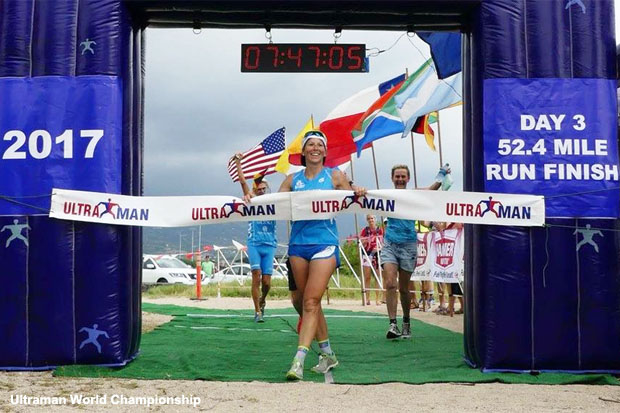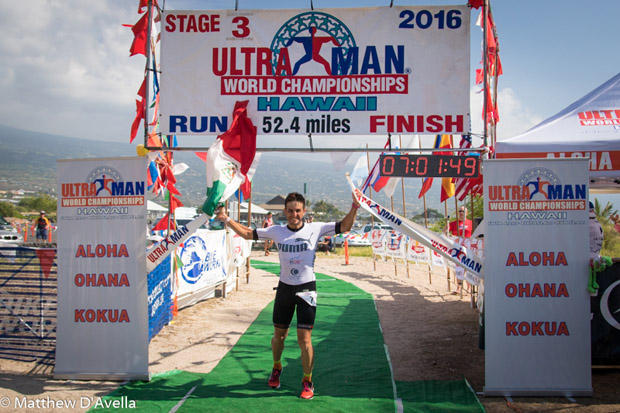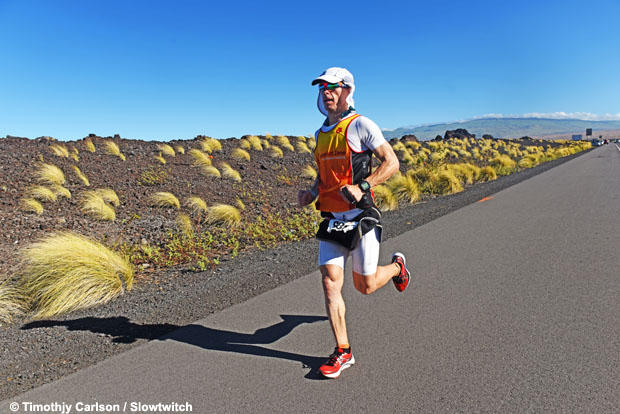Anatomy of an Ultra Duel
Today, a really long triathlon often ends when one party surrenders miles from the end. This year at the 3-day Ultraman World Championship, there was no surrender as two evenly matched men alternated punches from very different triathletic strong suits. Unlike the 1989 Iron War, these guys were not battling the whole way in close quarters. Instead, they alternated leads in seesaw order. They spent just a few seconds in proximity, but every day was rife with strategy and calculation.
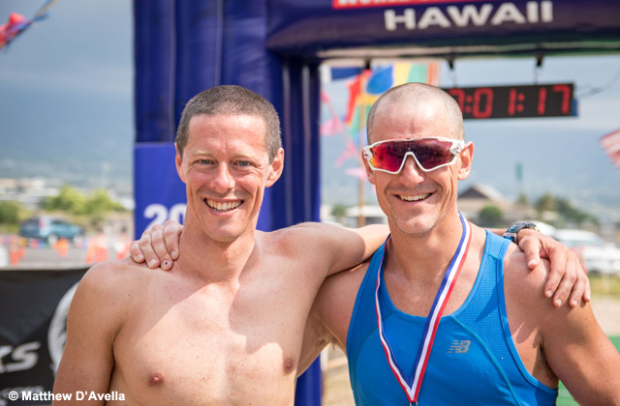
In 2015 Jeremy Howard finished third at Ultraman Hawaii, an hour and 44 minutes behind winner Mike Coughlin. Last year Rob Gray finished second by 44 minutes to Inaki De La Parra. With Coughlin and de la Parra not racing in 2017, Gray and Howard inherited the favorites’ roles and prepared intently. Improving their strengths and weaknesses, they shaved an hour off their Ultraman PRs. They also crafted strategies to employ against one another, producing the second closest men’s finish in Ultraman World Championship history.
Gray was born 41 years ago in South Africa on a farm just outside Johannesburg. He works for Google in Boulder, Colorado and runs an endurance sports coaching business. Gray searched a while before finding his athletic fit. “I can keep going for a long time without slowing down,” he said. “Ironman is too short and 100-mile trail runs are too long. Ultraman is my sweet spot.”
Jeremy Howard, 37, lives in Fredericksburg, Virginia and works as an endurance sports coach. In 2015, he made the podium at Ultraman Hawaii after an injury severely limited his training. “I had knots deep in my lower abs and it felt like my muscles were ripping off my groin,” said Howard. “Physical therapists and doctors looked for hernias and torn hip flexors but they couldn’t figure it out. So I took off two and a half months. After that, I did massive swim and bike volume and occasionally did a 15 minute jog. Someone suggested rolling out my lower abs with a lacrosse ball. After a couple weeks, a 20 minute jog started feeling OK. I knew I could do two days at Ultraman – then see about the run.” Howard finished with a 6:49 double marathon, eager to realize his Ultraman potential.
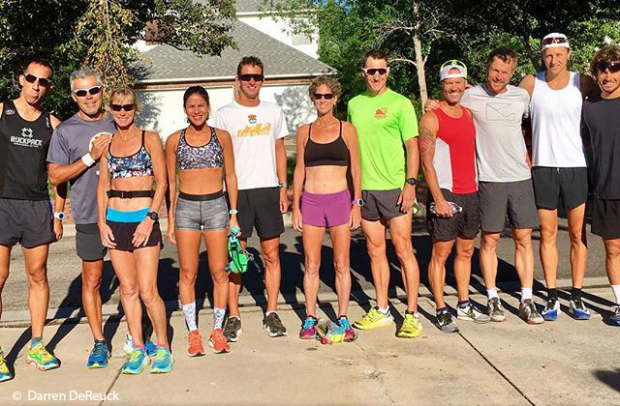
TRAINING
Gray worked with bike coach Matthew Bottrill of Great Britain, who advises Tim Don and Rachel Joyce. “He had me do some high intensity stuff,” says Gray. “And staying aero for as long as possible. I also ran with Colleen DeReuck and Joanna Zeiger, who pushed me to focus on quality, not volume.”
Howard hired coach Chris Thomas with an emphasis on bike training. “More on bike strength versus aerobic endurance,” he said. “I was healthy so I could do the rest of the training I wanted to do in 2015, focusing on tempo runs, not piling on miles.”
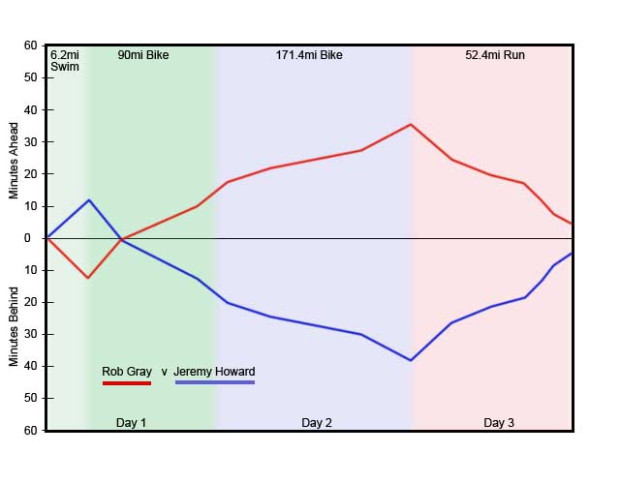
PRE RACE STRATEGY
When healthy, Howard and Gray are evenly matched with very different triathletic profiles. Howard is a superb swimmer, Gray a good one. Gray is a superior cyclist, Howard is decent but insecure on descents. Howard is a superb runner while Gray has to work hard to defend what he earns on the bike.
“This race is hugely strategic,” said Howard. “When I crewed for Inaki De La Parra last year, I got an appreciation for how the race unfolds and when it is best to push or hold back.” Howard also learned a lot about Gray. “Rob is a very strong cyclist and I knew my race was going to be about minimizing that damage before I could counterattack on the run. Last year Rob made a bold move on the double marathon and it didn’t work out. I figured he improved his pacing.”
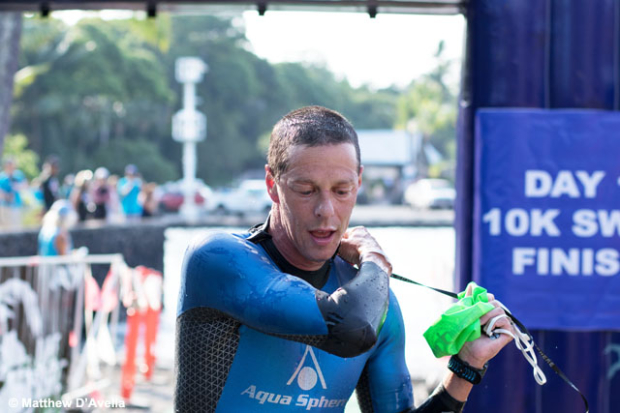
DAY ONE – 10k SWIM, 90 MILE BIKE
Howard led the swim in 2:27:43, 10:22 ahead of Gray. “I came out of the water a little too hot,” said Howard. “My heart rate was a little too high and the first two hours on the bike my effort was 20 watts lower than anticipated.”
Gray was third out of the water and started the bike in second place. “With that gap, I was prepared for a rough time catching up,” said Gray.
Gray felt an urgency on the Day 1 and Day 2 bike legs. “I thought I’d need an hour on him before the run,” said Gray. “When I passed him, I hoped to finish Day One with a 20 or 30 minute lead.”
Gray caught Howard about Mile 30. “I thought he was a little beat after making up 11 minutes,” said Howard. “I hoped he’d pushed too hard.”
“After Rob passed me, I pushed hard to minimize the gap,” said Howard. Expecting a strong headwind on the 4,000 foot climb to Volcanoes, Howard was pleased with a temporary switch in the wind. “At one point we had a tailwind, and the first hour of that climb Rob and I rode about the same. “But the last 30 minutes, we had a pretty significant headwind and near the top, I dropped back.”
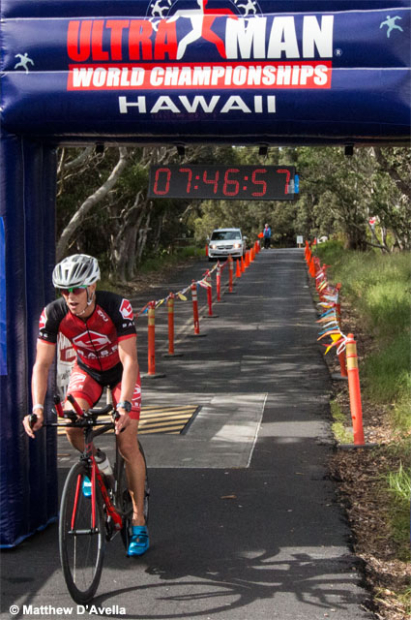
Howard lost 27 minutes to Gray on the Day One bike leg. But Gray fell short of his goal. “Jeremy had a good swim,” said Gray. “While I had a good ride, I got only 17 minutes on him.”
DAY TWO – 171.4 MILE BIKE
It started with a 20 mile downhill. “Arnaud [Selukov], Tony O’Keefe and I were out front,” said Gray. After a few minutes, Arnaud Selukov of France took off with what Gray termed “an Eddie Merckx, go-for-broke move.”
Soon the three leaders were riding solo. “My chain came off about 15 miles down a fast steep downhill,” said Gray. “It was a waste of time to stop so I kept freewheeling at 45 mph for the next 12 minutes. When the road leveled, I stopped and reset the chain.” Gray spent the next 20 miles making up the two minutes he lost to the Canadian while Selukov rode 4 minutes ahead.
Gray and O’Keefe never saw Howard, who trailed by 4.5 minutes at 23 miles.
“After the big effort on the first day, I didn’t feel great but I was able to hold steady,” said Howard, who trailed by 7 minutes at Hilo.
After Hilo, the course heads north on the Hamakua Coast, then climbs up to 2,670 feet at Waimea. Next came a 1,300 foot climb up the Kohala Road, which tops out at 3,900 feet. “I weigh about 170 pounds so I’m not super light,” said Gray. “But the winds shoved me all around.”
The stage finished with a 20-mile descent into Hawi, beset by swirling winds. “It is very steep, very curvy, very technical,” said Gray, who lost 8 minutes on the descent. “It was raining and the wind was gusting hard. So I took it conservatively – the last thing I wanted to do was crash out.”
Selukov rode 7:36:06, 14 minutes better than Gray (7:50:21) and 38 minutes better than Howard (8:14:22). After Day Two, Gray led the overall by 24 minutes on Selukov and 40 minutes on Howard.
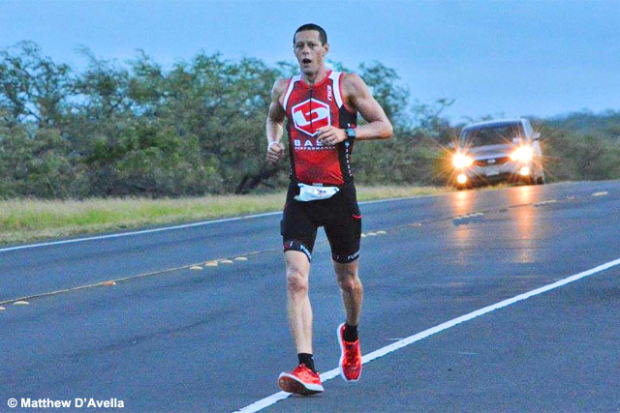
DAY THREE – DOUBLE MARATHON
Howard said he had a chance if his deficit was under an hour.
Gray said he could win it if his lead was an hour. But at 40 minutes, he wasn't sure.
How fast did they think they needed to run?
“I didn’t expect Jeremy would run much faster than 6:40,” said Gray. “At my absolute best I could run 7 hours.”
“I knew I would run better than 6:40,” said Howard. “Maybe better than 6:30.”
Selukov zoomed out front to start the downhill to Kawaihae. But the two contenders waited.
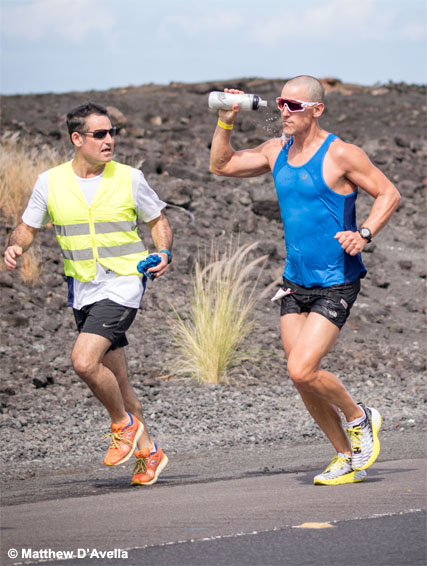
“I held back because I wanted to ease in and get settled,” said Gray. “After the first few miles, I gradually picked it up.”
“I wanted to keep my opening effort a bit lower,” Howard recalled. “But I couldn’t keep my heart rate as low as I wanted. By 5k I was in second place and Arnaud maintained a 100 meter lead until Mile 9 or 10.”
Howard struggled. “Usually we have a tailwind coming down from Hawi but this was a crosswind,” said Howard. “Leaning into an onshore wind, my ankles flexed to the right and I got blown into the rumble strip a few times. I tried to relax, but my heart rate kept rising.” Howard decided if it was just a biomechanical problem, he should go faster – and his heart rate didn’t rise.
Gray was playing defense. “I ran a little faster at times, slowed down some and took a few walk breaks just to mix it up and break up the repetitive strain,” he said. “Last year my quads packed in around Mile 38 and I vowed not to pound them this time.”
At the half marathon, Howard led by 13:18. If he maintained that relative pace advantage, he would win by 12 minutes. “I was feeling pretty comfortable,” he said.
“I wasn’t concerned,” said Gray. “It was very early and I just held steady until the first marathon.”
Howard hit the marathon in 3:08:29 and Gray in 3:30:55. Howard’s run lead was 22:26, cutting Gray’s overall lead to 18 minutes. If they maintained paces, Howard would win by 4 minutes.
“I knew he struggled at the end of the run last year, so I was pretty confident,” said Howard.
“I wanted to go from my epic blowup on the run last year to an even split,” said Gray. “I was confident I wouldn’t slow on the second marathon.”
Gray’s crew wasn't nervous. “They told me, ‘Just stick to the plan. No need to panic.’” said Gray. “I was feeling really good and Jeremy would have to run faster to keep closing on my overall lead. I didn’t think he could run another 3:08, whereas I could duplicate my 3:30.”

THE FINAL 13 MILES
When Howard reached the ¾ point [39 miles], his run lead was 28 minutes. “I knew that wasn't enough,” said Howard. There were reasons – he took a 3 and half minute bathroom stop and, in the four miles between Scenic Point and the Veterans Cemetery, runners faced a strong headwind where Howard only gained 30 seconds a mile.
“When I heard that Jeremy was 28 minutes ahead at Mile 39, that was great news for me because I only lost 6 minutes in the latest 13 miles,” said Gray. “As long as I kept the pressure on I could hold him.”
Almost 5 miles apart, Gray was chasing a moving target until Howard crossed the line. Meanwhile, Howard started cramping on the uphill at Scenic Point 20 miles from the end. “I tried to relax on the climbs and push on the flats and the descents,” said Howard. With 8 miles to go, he had cut 32 minutes from Gray’s overall lead and needed to slice a minute per mile to catch Gray and win.
Despite the good news at the 39 mile mark, Gray had his own nerve wracking developments.
First up, Gray’s Garmin went haywire. “It was doing some weird stuff,” he said. “I thought I was going 7:30 per mile but the Garmin showed I was running between 9:30 and 10:15 so I picked up the pace. To make sure, I started hitting the lap button at the mile markers and found I was actually running at 7:15 pace.”
Passing Honokohau Harbor – four miles to go – Gray came upon a red light with cross traffic and had to stop. “I had a good rhythm going but that broke it,” he said. “When I started running again, my legs were seizing up. It took me a minute to warm up again and I knew I couldn’t afford another stop.”
Howard pushed his pace to finish the run 25 minutes faster than his run to third place in 2015. When Gray’s wife Michelle found that Howard’s final run split was 6:24:17 she texted her husband’s crew. “Then I knew I had to finish under 7:04,” said Gray.
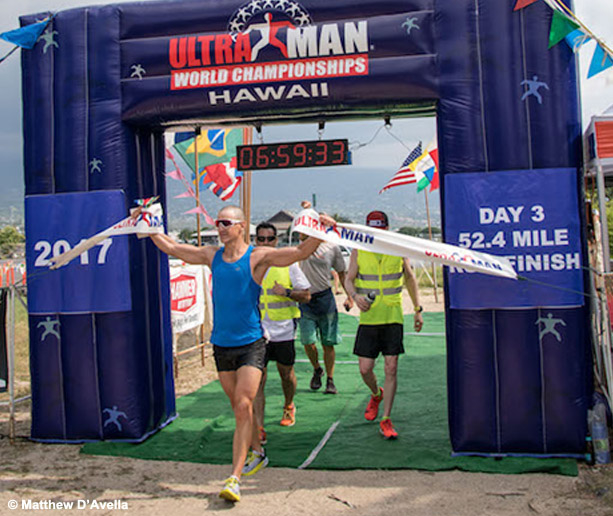
With three miles left, Gray’s run pacer Ian Hersey was on the verge of collapse. “He totally cramped and gave me his bottle of water,” said Gray. “Turns out our crew van ran out of water and Ian refused to take any more for himself.” “I was super dehydrated and almost passed out several times,” said Hersey.
What's more, while his watch was going wobbly, Gray’s mind started playing tricks. “I was nearing the finish,” said Gray. “I was a little disoriented and lost track of exactly where I was. The next mile marker was coming up, and I felt like it should be mile 98 but I couldn't quite make out what it was. I was running on empty and praying it was 98 and not 96, and a wave of relief flooded over me when I saw ‘98’.”
After entering the wide paved lot at the finish at the Old Airport, Gray saw his run time was 6:58 and put in a sprint. “I thought, ‘If I put the hammer down, I could go sub 7.’” Gray finished his run in 6:59:33 – 41:33 faster than his double marathon to second place last year. Howard’s run was 6:24:17 – 25 minutes faster than he ran in 2015 and 35:16 faster than Gray’s much improved 2017 run.
Selukov ran 7:33:06, 58:03 behind the winner.
Howard simply ran out of real estate. “Our battle really got the best out of me,” said Howard. “I can’t thank Rob enough for giving me the motivation to dig deep within myself.”
After their fierce battle, Gray gave Howard a half-joking compliment. “He told me, ‘I love you – and I hate you,’” laughed Howard.
Gray finished in 22:19:48, 5 minutes 28 seconds ahead of Howard. His margin of victory was the second closest in Ultraman Hawaii history. In 1986 James Freim beat William Woodruff by 5 seconds – the margin of defeat attributed to the time out Woodruff took at T1 to kiss his girlfriend, famed Ironman race director Valerie Silk.
Gray and Howard were astonished at what their duel wrought. “It pushed us to a level we didn’t think we were capable of,” said Gray. “It was so close – it could have gone either way.”


